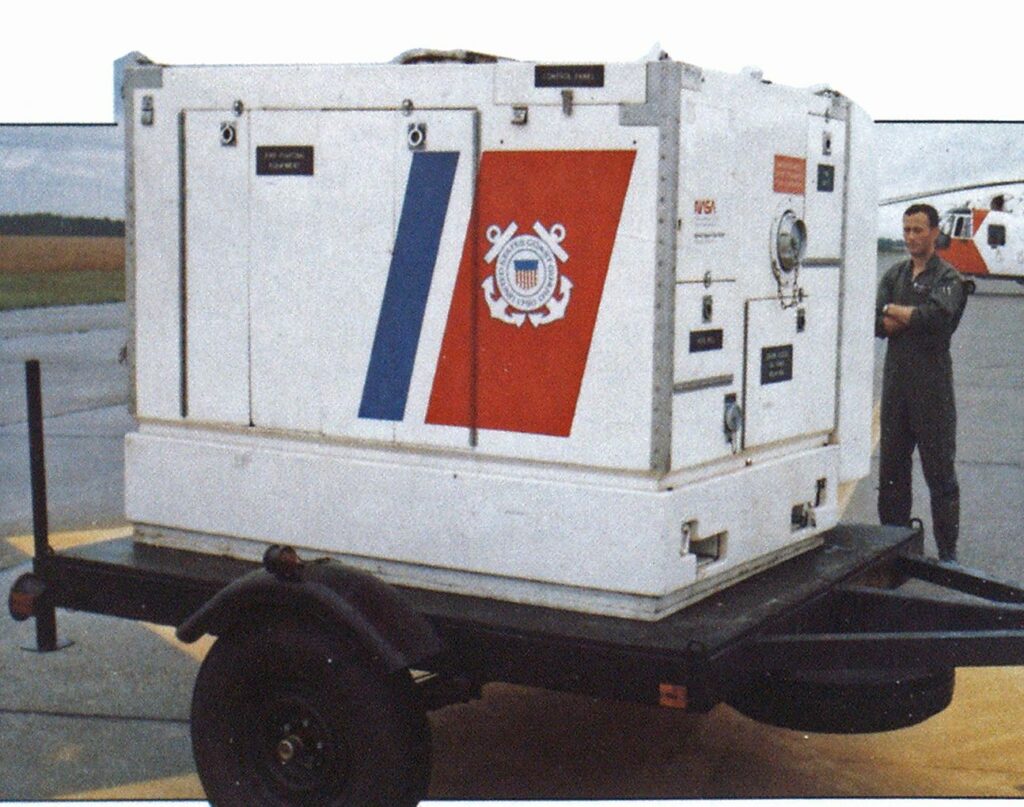
Mobile Fire Fighting Unit
WATER SUPPLY
When the Coast Guard decided to convert some patrol boats into fireboats, NASA was called upon to help design and develop an apparatus that could be mounted on these boats. The resulting portable pumper may prove to be a valuable fire fighting tool in a number of hard-to-reach areas.

A self-contained, lightweight, portable fire fighting unit, designed to improve harbor fire protection, has been developed by NASA’s George C. Marshall Space Flight Center in Alabama. Development and testing of the unit was sponsored by the United States Coast Guard and the Maritime Administration.
Weighing 1600 pounds dry (3000 pounds with fuel and equipment), the 4 X 5.4 X 6.8-foot skid-mounted gas turbine pumper can deliver up to 2500 gpm at 150-psi discharge pressure. The pumper can operate for four hours at maximum flow without refueling. The unit primes itself and can draft fresh water or salt water (through filters) 12 to 20 feet above the water’s surface. A high-capacity fire hydrant can also be used as a water source.
Operation
To operate, the unit’s suction hose is put into the water and the start button is pushed. The engine uses a single combined starter/generator that spins the engine to 15 percent of the pump’s rated speed. At this point, fuel ignition occurs and the engine accelerates to 60 percent speed. The engine then switches from starter to generator mode and the priming system is turned on by pressing a switch. In order to reduce battery drain during start-up, prime is not initiated until the generator is providing electrical power. This prime switch opens a prime valve and turns on a small pumping system.
This small pump discharges air from the suction hose, creating a partial vacuum within the suction line. Atmospheric pressure acting on the water’s surface then pushes water up the suction hose to the fire pump. A check valve in the main pump discharge line seals the main pump during prime.
When water begins flowing through the water cannons of the main pump, the prime switch is released, shutting off the prime pump and closing the prime valve. The prime valve shuts off the water between the two pumps after prime is achieved, otherwise water would flow through the primer air discharge line and be continuously dumped adjacent to the unit.
Loss of pump suction could instantly unload the pump and allow rapid engine acceleration or shearing of the pump shaft or quill shaft, resulting in overspeed and possible damage. Therefore, an automatic shutdown system (or engine governor system) is provided to prevent overspeed beyond 105 percent.
Once the prime valve is closed, the engine power level can be selected. The unit can be operated either manually or automatically. An automatic pressure control system will maintain the selected pressure level by adjusting the engine fuel flow and power.
Pumper components
The pumper consists of 11 major assemblies. All unit components, excluding the fuel tank and ancillary fire fighting equipment, are housed in the unit’s frame, which can be removed as an assembly with all components intact.
The primary element of the unit is the fuel tank, a wide, shallow design with a slight V, providing a fuel pickup trough. Two pickups are provided, each equipped with a flow valve to prevent air from entering the fuel line when one end of the unit is higher than the other. The shallow tank, the main base of the mobile unit, has a 155-gallon diesel fuel capacity. The fuel tank is the unit’s heaviest component (weighing 265 pounds dry and approximately 1200 pounds filled) and gives the unit a low and stable center of gravity.


The internal combustion turboshaft engine is rated at 370 hp for continuous operation at turbine outlet temperatures of 1360° or less. The engine has a single combustion chamber.
A two-stage, two-speed pump is separated from the unit’s engine section by a firewall. This prevents mixing of the engine compressor intake gas and the oil cooler gas, and prevents additional heating of compressor intake caused by the hot engine.
The assembly of the mobile fire fighting unit also includes ancillary fire fighting equipment: six 8-foot sections of suction hose, two float-type water pickups, two water cannons, and four 25-foot sections of 4-inch hose.
Four mobile fire fighting units are presently in use, explained Ralph Burns, the developer of the unit. Dow Chemical purchased a 2500-gpm unit several years ago, after it effectively extinguished a chemical fire at the company’s College Station, Tex., complex. The City of Miami, Fla., Fire Department has a 2500-gpm unit mounted on an amphibious vehicle, allowing the unit to be used on land or on water. The Navy has two 2500-gpm units and is expecting delivery of a third (5000gpm) unit.
Pumper applications
While the mobile unit has significant special-purpose applications, it is not intended to replace fire pumpers in their normal range of operations. However, potential applications of the mobile unit include: mounting the unit on a boat 30 feet or longer, thereby converting it to a fireboat; mounting the unit on a small truck and have it operate at reduced capacity from conventional fire hydrants; air lifting the unit to remote areas with access to small streams where it can be set up to deliver water approximately 1 mile from the water source; pumping out water from boats in danger of sinking; transporting the unit by helicopter to fight offshore oil well, oil field or marine fires.


